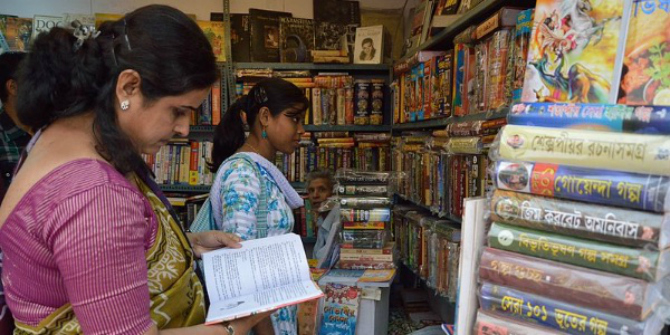 Drawing on a range of case studies, including analysis of the reality of work in the creative industries, urban regeneration and current government cultural policy in the UK, this book discusses the idea of value in the cultural sector, showing how value plays out in cultural organizations. Ruth Adams finds that Dave O’Brien’s contribution functions effectively as a primer on the topic, but has sufficient depth to yield useful insight to students and researchers at all levels, and beyond university into the workplace.
Drawing on a range of case studies, including analysis of the reality of work in the creative industries, urban regeneration and current government cultural policy in the UK, this book discusses the idea of value in the cultural sector, showing how value plays out in cultural organizations. Ruth Adams finds that Dave O’Brien’s contribution functions effectively as a primer on the topic, but has sufficient depth to yield useful insight to students and researchers at all levels, and beyond university into the workplace.
 Cultural Policy: Management, Value and Modernity in the Creative Industries. Dave O’Brien. Routledge. October 2013.
Cultural Policy: Management, Value and Modernity in the Creative Industries. Dave O’Brien. Routledge. October 2013.
What is the value of culture? Far from an idle philosophical debate, this is a question with genuine and concrete implications, made manifest in cultural policy and creative practice. Should public arts funding support and legitimize only canonical high culture, or promote a more expansive notion of creativity? Whose culture should be represented, and who gets to decide?
Dave O’Brien’s new book, Cultural Policy: Management, Value and Modernity in the Creative Industries, offers a concise and critically astute survey of this complex and often contradictory field. Summarising and synthesising an impressive range of key texts from a variety of disciplines, the book demonstrates clearly and convincingly how cultural policy emerged from the wider historical and ideological context of modernity, and from associated formations of government, economy, industry and the individual. O’Brien brings to the discussion an extensive knowledge of the subject gained from his teaching and research at City University, and a secondment to the DCMS.
The book makes good its claim to demonstrate the significance of cultural policy ‘as both an important part of the modern world and a distinctive, interdisciplinary, academic field’, including some thought-provoking reflections on the far from straightforward relationship between the academic study of cultural policy and its practice. O’Brien identifies a number of the ways in which social science is used and abused by policy makers, and the often inflated claims that are made for the potential of culture to address the social and economic problems of post-industrial societies, from crime and unemployment to ‘poverty of aspiration’. He reflects too on the extent to which scholars are complicit in the often very selective adoption of their concepts and recommendations.
The arguments are illustrated with in-depth case studies including Liverpool’s 2008 stint as European Capital of Culture and the BBC. The latter has employed the discourses of public and cultural value to justify the extension of its charter and the license fee, exemplifies the rise of ‘the audit society’, and has been a key player in the cultural regeneration of the north west of England; it serves therefore as an effective case in point of a variety of trends and tendencies in cultural policy.
Well chosen as they are, these examples do however point towards the one possible shortcoming of the book, which is its rather UK-centric focus. Although this can be to some extent justified by O’Brien’s argument that ‘British models of creative industries have been exported to influence cultural policies across the globe’, some indication of how these had been made manifest in these different contexts would have been illuminating. As both the student body in UK universities and the creative sector becomes ever more global, analyses that restrict their scope to national frameworks may limit their appeal.

Nonetheless, the book is well pitched to engage its intended audience of students of the Cultural and Creative Industries. It tackles a range of key areas such as the institutional and discursive contexts for cultural policy, culture-led regeneration, cultural value, the relationship between class and taste, and the role of cultural organisations. It functions effectively as a primer on the topic, but has sufficient depth to yield useful insight to students and researchers at all levels, and beyond university into the workplace. With the benefit of a deeper understanding and experience of the cultural sector and its idiosyncrasies, readers may well appreciate more fully the significance of some of the more nuanced analysis, particularly that which deals with the nature of creative work and cultural labour, one of the book’s real strengths.
That a significant proportion of creative work is done for free, during leisure time and perhaps even unwittingly, the ‘prosumer’ – who simultaneously consumes and creates the content of social media sites is paradigmatic here – is connected to broader characteristics of cultural labour. O’Brien argues that creative work is both privileged and exploited labour, and an issue that goes far beyond the scandal of unpaid internships. Because creativity is seen as life enhancing, aspirational and enviable, not least by cultural workers themselves, the realities of working hours and conditions, remuneration and security are often obscured. The book observes that, reinforced by romantic notions that art requires sacrifice, and a belief that creative workers are ‘paid for their hobby’, there is a widespread assumption that the prestige and satisfactions of creative labour ought themselves to be sufficient, making tackling structural inequalities and exploitation within the sector extremely problematic. This is compounded by the phenomenon in late capitalist societies where the apparently autonomous, creative self becomes a commodity to be traded, ‘life becomes a pitch’, relationships are instrumentalised, and failure individualised.
Such issues present creative workers with unenviable choices, but they also caused this reader to reflect on the ethical conundrums they pose to academics educating the next generation of cultural workers. This book and the research it draws on highlight many of the shortcomings and inequities of cultural policy and practice, and while this is an important critique and corrective, it is nonetheless the case that this material is predominantly produced and communicated within and by Creative Industries departments in universities. This has been an area of exponential growth in Higher Education over the last decade, and academics that work within this area must acknowledge the opportunities and threats that arise from government interest in and the increasing marketability of the subject. While, on the one hand, they may seek to produce graduates capable of critical thinking and prepared for the realities of their working lives, teaching programmes and departments arguably reproduce the mythology of creativity and cultural value, and exacerbate the very oversupply of labour identified as a contributory factor to the exploitation endemic to the cultural sector.
——————————————–
Ruth Adams has worked as a lecturer in Cultural & Creative Industries at King’s College London since 2003, where she convenes a postgraduate programme and teaches courses on Heritage, Youth Subcultures and the relationship between Culture & Commerce. She writes about museums, punk rock, and the enduring potency of the British royal family as an image and an ideal. She is interested in how nostalgia and perceptions of the past shape our understanding of the present, legacies of colonialism, how socio-economic circumstances influence cultural choices, in the interplay between high art and popular culture, and examples of the eruption of the avant-garde into the everyday. Read more reviews by Ruth.







